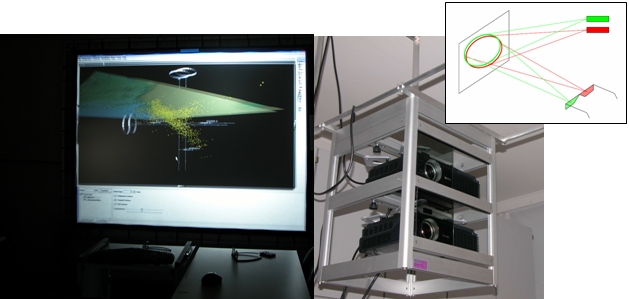 Web Content Display Web Content Display
3D visualization lab (08/2007)Significant advances in preparing a SFB database have been made. To increase the value of data now available, a 3D visualization system, based on stereo projection, has been built and installed. Compatibility with software widely used within the SFB (e.g. Fledermaus GIS, IGMAS, GoCAD) has been confirmed and an integrated interpretation of different datasets by simultaneous presentation using real 3D impression is possible. This system for 3D visualization of SFB data was built in 2006 (see fig. 4). It consists of two DLP projectors, a special rack, polarizing filters, a 2 m × 1.5 m silver coated screen, 30 pairs of polarizing glasses to aid visualization, a 3D controlling mouse and an auto-stereoscopic display for single-user 3D visualization. To allow real-time visualization of large models, a new computer system was prepared. This system is based on an Intel Core2Duo processor with 2GB RAM and a professional PNY Nvidia Quadro 4500 FX graphics card with 512MB RAM. The system is compatible with existing geoscientific software tools used within the SFB. These tools include Fledermaus GIS, Paraview, GoCAD, native OpenGL and IGMAS / IVIS3D. In principle, all software with an OpenGL or Direct3D graphics interface can be used by the help of the more3D interface software and/or directly by the professional Quadro drivers. Z2 plans to provide well adopted software templates in major programming languages compatible to this system (see section 3.2.2.2). In 2007, the necessary equipment for installing this system in a dedicated projection room (new carpet, screen, roller blinds and projector rack) was financed by the CAU Kiel. Recently we submitted a paper concluding our experience with the combined geodata management approaches undertaken to integrate geodata management and 3D visualization to "Computers & Geosciences", Elsevier (Damm and Götze, 2007).
Figure 4: 3D stereoscopic projection equipment. The two beamers (right picture) deliver two perspective views through polarization filters onto a silver coated screen (left picture), which preserves the polarization state of each picture. Viewing through polarizing glasses provides each eye its distinct view (compare sketch in the upper right corner). |
 Events Events
Kieler Wissenschaftler fühlen den 'Puls der Erde' Wie funktioniert die Recyclingmaschine der Erde?Nach elf Jahren endet der Kieler Sonderforschungsbereich 574 zu Subduktionszonen Final colloquium of SFB 574 Teilprojekt ÖffentlichkeitsarbeitMEERESFORSCHUNG FÜR MICH UND DICH |
|
©SFB574 // Wischhofstrasse 1-3 // D-24148 Kiel // T. +49 (0)431 600 1413 // elange [AT] geomar.de






